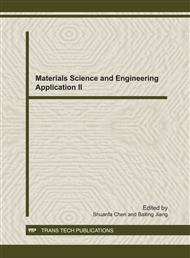p.467
p.472
p.477
p.486
p.491
p.499
p.507
p.514
p.520
Orthogonal Experiment Study on the Hydrogen Desorption Properties of NaAlH4 and LiAlH4
Abstract:
Orthogonal experiment design and variance analysis were adopted to investigate the hydrogen desorption properties of NaAlH4 and LiAlH4, which consisted of three stages, ball-milled under argon. Optimum milling condition was very important for the performance of NaAlH4 and LiAlH4, which was obtained from the orthogonal experiments. The orthogonal experiment design considered three experimental factors, i.e. weight ratio of ball to power, weight ratio of ɸ8 ball to ɸ4 ball and milling time, which varied on three different levels, respectively. According to the range analysis and variance analysis from the orthogonal experiments, the weight ratio of ball to powder and ɸ8 ball to ɸ4 ball had more impacts on the hydrogen desorption time of NaAlH4,while the most sensitive influencing factor of LiAlH4 was milling time. NaAlH4 had the optimum performance when the weight ratio of ball to power was 30:1, the weight ratio of ɸ8 ball to ɸ4 ball was 0.5:1 and milling time was 0.5h. LiAlH4 had the optimum performance when the weight ratio of ball to power was 40:1, the weight ratio of ɸ8 ball to ɸ4 ball was 0.5:1 and milling time was 2h.
Info:
Periodical:
Pages:
491-498
Citation:
Online since:
December 2011
Authors:
Keywords:
Price:
Сopyright:
© 2012 Trans Tech Publications Ltd. All Rights Reserved
Share:
Citation:


